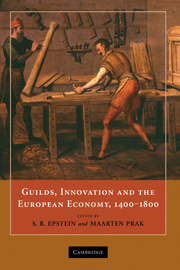Book contents
- Frontmatter
- Contents
- List of Contributors
- Acknowledgments
- Introduction: Guilds, Innovation, and the European Economy, 1400–1800
- 1 Craft Guilds, the Theory of the Firm, and Early Modern Proto-industry
- 2 Craft Guilds, Apprenticeship, and Technological Change in Pre-industrial Europe
- 3 Subcontracting in Guild-based Export Trades, Thirteenth–Eighteenth Centuries
- 4 Circulation of Skilled Labour in Late Medieval and Early Modern Central Europe
- 5 Painters, Guilds, and the Art Market during the Dutch Golden Age
- 6 Craft Guilds and Technological Change: The Engine Loom in the European Silk Ribbon Industry in the Seventeenth and Eighteenth Centuries
- 7 Guilds, Technology, and Economic Change in Early Modern Venice
- 8 Inventing in a World of Guilds: Silk Fabrics in Eighteenth-century Lyon
- 9 ‘Not to Hurt of Trade’: Guilds and Innovation in Horology and Precision Instrument Making
- 10 Reaching beyond the City Wall: London Guilds and National Regulation, 1500–1700
- 11 Guilds in Decline? London Livery Companies and the Rise of a Liberal Economy, 1600–1800
- Index
10 - Reaching beyond the City Wall: London Guilds and National Regulation, 1500–1700
Published online by Cambridge University Press: 24 June 2009
- Frontmatter
- Contents
- List of Contributors
- Acknowledgments
- Introduction: Guilds, Innovation, and the European Economy, 1400–1800
- 1 Craft Guilds, the Theory of the Firm, and Early Modern Proto-industry
- 2 Craft Guilds, Apprenticeship, and Technological Change in Pre-industrial Europe
- 3 Subcontracting in Guild-based Export Trades, Thirteenth–Eighteenth Centuries
- 4 Circulation of Skilled Labour in Late Medieval and Early Modern Central Europe
- 5 Painters, Guilds, and the Art Market during the Dutch Golden Age
- 6 Craft Guilds and Technological Change: The Engine Loom in the European Silk Ribbon Industry in the Seventeenth and Eighteenth Centuries
- 7 Guilds, Technology, and Economic Change in Early Modern Venice
- 8 Inventing in a World of Guilds: Silk Fabrics in Eighteenth-century Lyon
- 9 ‘Not to Hurt of Trade’: Guilds and Innovation in Horology and Precision Instrument Making
- 10 Reaching beyond the City Wall: London Guilds and National Regulation, 1500–1700
- 11 Guilds in Decline? London Livery Companies and the Rise of a Liberal Economy, 1600–1800
- Index
Summary
Historians have traditionally seen guilds as local-minded associations whose interests and jurisdictions rarely strayed far beyond the outer walls of the town or city to which they belonged. However, just as few crafts did not rely in some way upon the world beyond the town walls, whether for labour, technology, raw materials, or markets, few guilds lacked mechanisms and procedures – apprenticeship, quality control, price regulation, and so on – designed in part to mediate their needs with this ‘outside’ world. In this chapter we explore a development in London guilds' concern with the rest of the country that has received little attention from historians: the establishment and operation of nationwide jurisdictions and monopolies by a number of metropolitan guilds.
National jurisdictions were unusual. For the most part in England, as in the rest of Europe, the jurisdictions of craft guilds stopped at the town or city's gate or extended only a few miles into its immediate suburbs and hinterland. It is not surprising then that nationwide guild jurisdictions in England have tended to be ignored or dismissed, at best relegated to the footnotes of company histories. The few examples that are better known tend to be those that were most intimately associated with the financial problems and opportunism – even corruption – of the crown.
- Type
- Chapter
- Information
- Guilds, Innovation and the European Economy, 1400–1800 , pp. 288 - 315Publisher: Cambridge University PressPrint publication year: 2008
- 3
- Cited by

